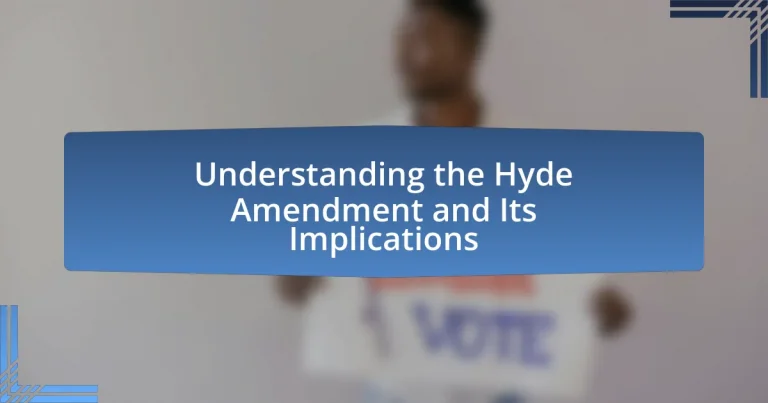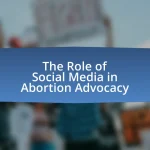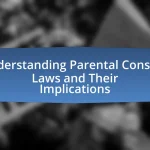The Hyde Amendment is a legislative provision enacted in 1976 that prohibits the use of federal funds for abortions, except in cases of rape, incest, or when the mother’s life is at risk. This amendment significantly impacts low-income women who rely on Medicaid for healthcare, creating barriers to accessing abortion services. The article explores the historical context of the Hyde Amendment, key figures involved in its passage, its main provisions, and its implications for reproductive rights and public health outcomes. Additionally, it discusses current debates surrounding the amendment, arguments for and against it, and potential future changes in legislation and public opinion.
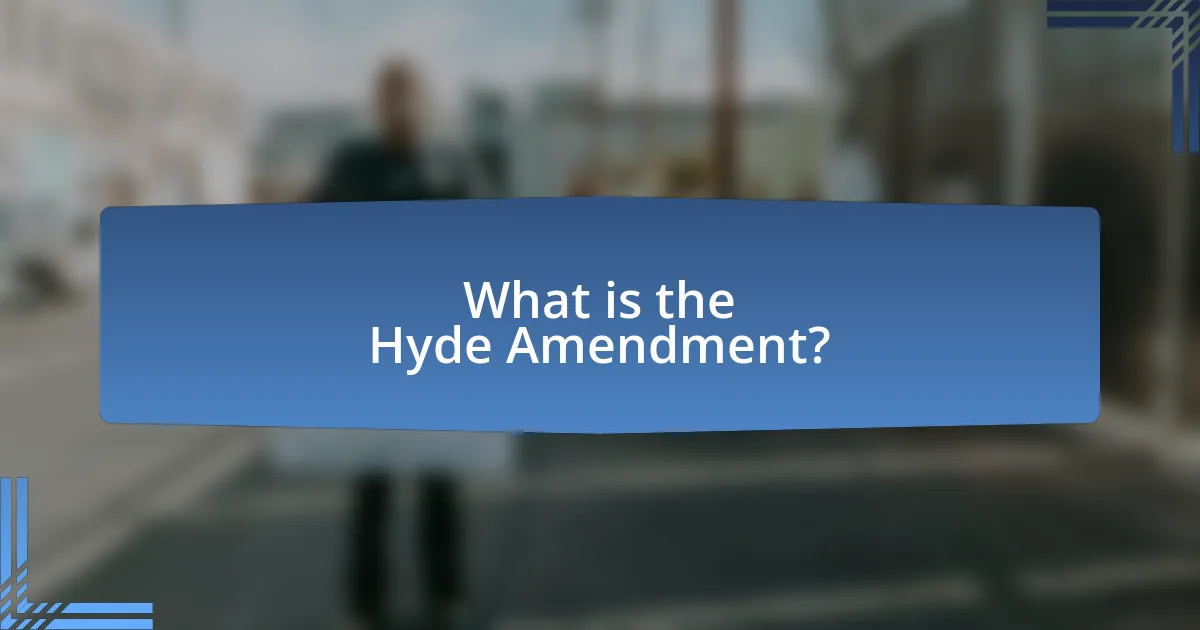
What is the Hyde Amendment?
The Hyde Amendment is a legislative provision that prohibits the use of federal funds for abortions, except in cases of rape, incest, or when the mother’s life is in danger. Enacted in 1976, it has been included in annual appropriations bills for the Department of Health and Human Services, effectively restricting access to abortion services for low-income women who rely on Medicaid. The amendment reflects ongoing debates about federal funding and reproductive rights in the United States.
How did the Hyde Amendment come into existence?
The Hyde Amendment came into existence as a legislative response to the Supreme Court’s 1973 Roe v. Wade decision, which legalized abortion nationwide. Introduced by Congressman Henry Hyde in 1976, the amendment aimed to restrict federal funding for abortions under Medicaid, reflecting the growing political and social opposition to abortion. The amendment was passed as part of the Labor, Health and Human Services, Education, and Related Agencies Appropriations Act, and has been renewed and modified in subsequent years, influencing federal abortion policy significantly.
What historical context led to the creation of the Hyde Amendment?
The Hyde Amendment was created in response to the growing debate over federal funding for abortion services in the United States during the 1970s. Following the Supreme Court’s decision in Roe v. Wade in 1973, which legalized abortion nationwide, there was significant concern among conservative lawmakers and constituents about the use of federal funds for abortions. The amendment, introduced by Congressman Henry Hyde in 1976, aimed to restrict federal funding for abortions under Medicaid, reflecting the political and social climate that prioritized anti-abortion sentiments. This legislative action was influenced by the broader context of the women’s rights movement and the pushback from various religious and conservative groups who opposed abortion, leading to the eventual passage of the Hyde Amendment as part of the Labor, Health and Human Services, Education, and Related Agencies Appropriations Act.
Who were the key figures involved in the Hyde Amendment’s passage?
The key figures involved in the Hyde Amendment’s passage include Congressman Henry Hyde, who sponsored the amendment, and various members of Congress who supported it during the legislative process. The Hyde Amendment was enacted in 1976, primarily as a response to the Supreme Court’s Roe v. Wade decision, and aimed to restrict federal funding for abortions. Henry Hyde, a Republican from Illinois, played a crucial role in advocating for the amendment, emphasizing moral and fiscal arguments against using taxpayer money for abortion services. His leadership and the backing of a coalition of conservative lawmakers were instrumental in the amendment’s approval.
What are the main provisions of the Hyde Amendment?
The main provisions of the Hyde Amendment prohibit the use of federal funds for abortions, except in cases of rape, incest, or when the mother’s life is in danger. This amendment was first passed in 1976 and has been included in annual appropriations bills for the Department of Health and Human Services. The Hyde Amendment effectively restricts access to abortion services for low-income women who rely on Medicaid, as it limits their ability to obtain coverage for the procedure.
What types of abortions are affected by the Hyde Amendment?
The Hyde Amendment affects federally funded abortions, specifically prohibiting the use of federal funds for abortions except in cases of rape, incest, or when the mother’s life is in danger. This legislative provision was first enacted in 1976 and has been a significant factor in limiting access to abortion services for low-income individuals who rely on Medicaid for healthcare. The amendment’s restrictions mean that many women seeking abortions are unable to afford the procedure without federal assistance, thereby impacting their reproductive choices.
How does the Hyde Amendment impact federal funding for abortions?
The Hyde Amendment prohibits federal funding for abortions, except in cases of rape, incest, or when the mother’s life is in danger. This legislative measure, first enacted in 1976, effectively restricts the use of federal funds for abortion services, impacting programs like Medicaid, which serves low-income individuals. As a result, many women who rely on federal assistance face significant barriers to accessing abortion care, as they must either pay out-of-pocket or seek alternative funding sources. The amendment has been a focal point in debates over reproductive rights and healthcare access in the United States.
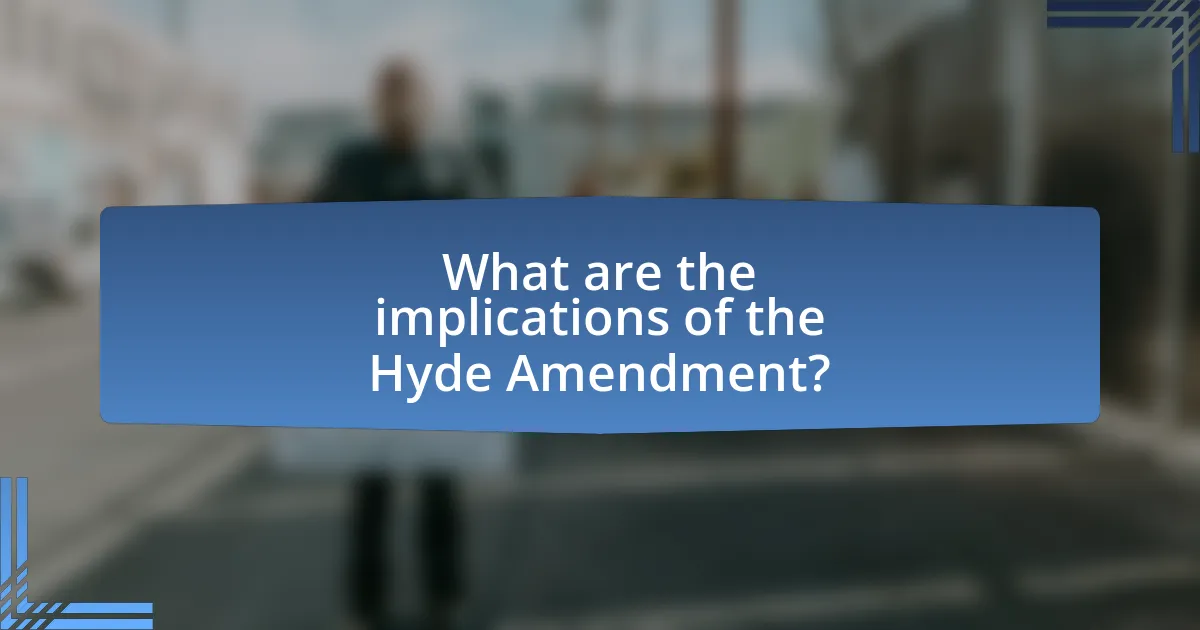
What are the implications of the Hyde Amendment?
The Hyde Amendment restricts federal funding for abortions, primarily affecting low-income individuals who rely on Medicaid for healthcare. This limitation leads to significant disparities in access to abortion services, as many women are unable to afford the procedure without financial assistance. According to the Guttmacher Institute, states that choose to use their own funds to cover abortions often see higher rates of access, while those adhering strictly to the Hyde Amendment experience increased barriers. Consequently, the Hyde Amendment has profound implications for reproductive rights, healthcare equity, and the socioeconomic status of women, particularly those from marginalized communities.
How does the Hyde Amendment affect women’s reproductive rights?
The Hyde Amendment restricts federal funding for abortions, significantly impacting women’s reproductive rights by limiting access to abortion services for low-income women who rely on Medicaid. This amendment, enacted in 1976, prohibits the use of federal funds for abortions except in cases of rape, incest, or when the woman’s life is in danger. As a result, many women face financial barriers to obtaining abortions, leading to disparities in reproductive healthcare access based on income and insurance coverage. Studies indicate that states with restrictive abortion funding policies see higher rates of unintended pregnancies and maternal health complications, underscoring the amendment’s profound implications on women’s health and autonomy.
What are the consequences for low-income women seeking abortions?
Low-income women seeking abortions face significant barriers, including financial constraints and limited access to healthcare services. The Hyde Amendment restricts federal funding for abortions, which disproportionately affects low-income women who rely on Medicaid for healthcare. As a result, these women may be forced to carry unwanted pregnancies to term, leading to negative health, economic, and social outcomes. Studies indicate that women denied abortions are more likely to experience economic hardship, increased reliance on public assistance, and adverse mental health effects.
How does the Hyde Amendment influence state-level abortion policies?
The Hyde Amendment significantly restricts federal funding for abortions, which influences state-level abortion policies by compelling states to fill the funding gap with their own resources or to adopt similar restrictions. As a result, many states have enacted laws that limit public funding for abortions, reflecting the limitations imposed by the Hyde Amendment. For instance, states like Texas and Ohio have implemented policies that mirror the Hyde Amendment, restricting Medicaid coverage for abortion services, thereby affecting access to abortion for low-income individuals. This creates a landscape where state-level policies are often aligned with the federal restrictions established by the Hyde Amendment, leading to disparities in access to abortion services across different states.
What are the broader societal impacts of the Hyde Amendment?
The broader societal impacts of the Hyde Amendment include increased financial barriers to abortion access for low-income individuals, particularly women of color. This amendment prohibits federal funds from being used for abortions, which disproportionately affects those who rely on Medicaid for healthcare. As a result, studies indicate that the amendment has led to a significant increase in unintended pregnancies and has forced many women to carry unwanted pregnancies to term, impacting their economic stability and health outcomes. Research from the Guttmacher Institute shows that states with restrictive abortion funding experience higher rates of maternal mortality and poorer health outcomes for women, highlighting the amendment’s far-reaching implications on public health and social equity.
How does the Hyde Amendment affect public health outcomes?
The Hyde Amendment negatively impacts public health outcomes by restricting federal funding for abortions, which can lead to increased rates of unintended pregnancies and unsafe abortions. Research indicates that states with more restrictive abortion funding policies experience higher maternal mortality rates and poorer health outcomes for women. For instance, a study published in the American Journal of Public Health found that women denied abortions due to funding restrictions were more likely to face health complications and economic hardship, demonstrating a direct correlation between the Hyde Amendment and adverse public health consequences.
What role does the Hyde Amendment play in the national abortion debate?
The Hyde Amendment restricts federal funding for abortions, significantly influencing the national abortion debate. Enacted in 1976, it prohibits the use of federal funds for abortions except in cases of rape, incest, or when the mother’s life is at risk. This limitation has led to ongoing discussions about reproductive rights, access to healthcare, and the implications for low-income women who rely on federal assistance. The amendment has been a focal point for both pro-choice and pro-life advocates, shaping legislative agendas and public opinion on abortion access in the United States.

What are the current discussions surrounding the Hyde Amendment?
Current discussions surrounding the Hyde Amendment focus on its implications for federal funding of abortion services. The Hyde Amendment, enacted in 1976, restricts federal funds from being used for abortions except in cases of rape, incest, or when the mother’s life is at risk. Recently, debates have intensified regarding its impact on low-income individuals and marginalized communities, as many argue that the amendment disproportionately affects those who rely on Medicaid for healthcare. Legislative efforts to repeal or modify the Hyde Amendment have gained traction, particularly among Democratic lawmakers, who advocate for broader access to reproductive healthcare. Additionally, public opinion polls indicate a growing support for the repeal of the amendment, reflecting changing societal attitudes toward abortion rights.
What are the arguments for and against the Hyde Amendment?
The arguments for the Hyde Amendment include the belief that it prevents the use of federal funds for abortions, aligning with the views of many who consider abortion morally objectionable. Supporters argue that it reflects the values of taxpayers who do not wish to fund abortions and promotes alternatives such as adoption. Conversely, arguments against the Hyde Amendment assert that it disproportionately affects low-income women and women of color, limiting their access to safe and legal abortions. Critics contend that the amendment infringes on women’s rights to make decisions about their own bodies and undermines public health by forcing women to seek unsafe alternatives.
What do proponents of the Hyde Amendment argue?
Proponents of the Hyde Amendment argue that federal funds should not be used to finance abortions, as they believe this aligns with the moral and ethical views of many Americans who oppose abortion. They assert that using taxpayer money for abortion services undermines the sanctity of life and promotes a culture that devalues human life. Additionally, supporters contend that the amendment protects the rights of individuals who do not wish to fund abortions through their taxes, reflecting a broader principle of conscience and fiscal responsibility.
What are the main criticisms of the Hyde Amendment?
The main criticisms of the Hyde Amendment include its restriction on federal funding for abortions, which disproportionately affects low-income women and women of color. Critics argue that this limitation creates inequities in access to reproductive healthcare, as those who cannot afford to pay for abortions out-of-pocket are significantly impacted. Additionally, opponents contend that the amendment infringes on women’s rights to make decisions about their own bodies and undermines the principle of bodily autonomy. Studies have shown that when financial barriers are imposed, the rates of unsafe abortions increase, highlighting the public health implications of the Hyde Amendment.
How might the Hyde Amendment evolve in the future?
The Hyde Amendment may evolve through legislative changes, judicial rulings, or shifts in public opinion regarding abortion funding. Recent trends indicate increasing advocacy for reproductive rights, which could lead to efforts to repeal or modify the amendment. For instance, in 2021, the U.S. House of Representatives passed a bill aimed at repealing the Hyde Amendment, reflecting a significant political shift. Additionally, various states have enacted laws that challenge existing restrictions, suggesting a potential for broader changes at the federal level. These developments indicate that the Hyde Amendment’s future is likely to be influenced by ongoing political dynamics and societal attitudes toward reproductive health.
What legislative changes are being proposed regarding the Hyde Amendment?
Legislative changes proposed regarding the Hyde Amendment include efforts to repeal the amendment, which currently restricts federal funding for abortions except in cases of rape, incest, or when the mother’s life is at risk. Recent proposals aim to ensure that federal funds can be used for abortion services, reflecting a shift towards broader reproductive rights. For instance, the Women’s Health Protection Act, introduced in Congress, seeks to codify the right to access abortion and eliminate restrictions like those imposed by the Hyde Amendment, highlighting a significant movement towards expanding access to reproductive healthcare.
How do recent court rulings impact the Hyde Amendment’s future?
Recent court rulings have created significant uncertainty regarding the future of the Hyde Amendment, which restricts federal funding for abortions. Courts have increasingly scrutinized the constitutionality of such funding restrictions, particularly in light of evolving interpretations of reproductive rights. For instance, the Supreme Court’s decision in 2022 to overturn Roe v. Wade has prompted lower courts to reassess the legal foundations of the Hyde Amendment, leading to challenges that could potentially weaken or eliminate its enforcement. These developments indicate a shifting legal landscape that may ultimately affect the amendment’s viability in future legislation and judicial review.
What can individuals do to engage with the Hyde Amendment’s implications?
Individuals can engage with the Hyde Amendment’s implications by advocating for reproductive rights and participating in policy discussions. Advocacy can include contacting legislators to express support for or opposition to the amendment, as it restricts federal funding for abortions, impacting low-income individuals. Participation in local and national campaigns, such as rallies or educational forums, raises awareness about the amendment’s effects on healthcare access. Engaging with organizations that focus on reproductive health can also provide resources and platforms for individuals to voice their concerns and influence public policy.
